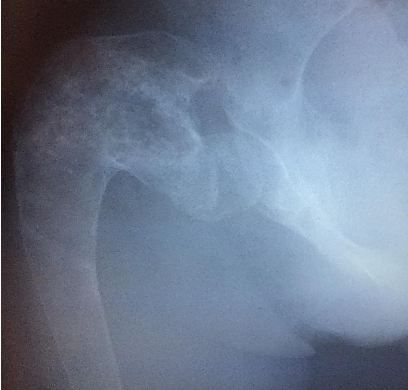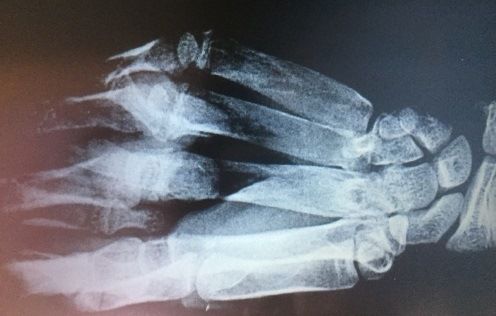Hip Pain, Irregular Skin Lesions in a 12-year-old Girl
A symptom and a sign from a triad that is pathognomonic for this patient's condition. What's your Dx?
Figure 1.

Figure 2.

Figure 3.

A mother brought in her 12 year-old daughter for evaluation. The young lady complains of a right leg limp over the last 4 years that seems to be getting worse. The limp began gradually and she denies any trauma to her leg. She now thinks that her right leg is shorter than her left leg. She denies any fevers or significant pain in the right leg. She also reports that she had her menarche at age 3 and has been having monthly menses since that time. She denies any family history of precocious puberty. Her younger brother and both parents are healthy. She denies taking any medications or supplements.
Her mother states that she had at least two leg fractures and an arm fracture between ages 4 and 7. Physical exam was remarkable for skin lesions (Figure 1, right), diffuse tenderness to palpation around her right hip, and a 1cm leg-length discrepancy (right shorter than left.) X-ray of her right hip (Figure 2) and right hand (Figure 3) are shown at right. (Please click on images to enlarge.)
What is the most likely diagnosis?
A. Child abuse
B. Congenital adrenal hyperplasia
C. McCune-Albright Syndrome
D. Neurofibromatosis type 1
E. Cushing’s syndrome
Please click here for answer and discussion.
The correct answer is C. McCune-Albright Syndrome
The classic McCune-Albright syndrome (MAS) triad is peripheral precocious puberty, irregular café-au-lait skin pigmentation, and fibrous bone dysplasia.1
The irregular borders of the pigmentations – a “Coast of Maine” appearance,2 are seen in Figure1.Café-au-lait spots from other disorders typically have smooth borders – a “Coast of California” appearance. The proximal femur, seen in Figure 2, exhibits the classic “Shepherd’s Crook” deformity of fibrous dysplasia2,3 as well as typical mixed “ground glass” and sclerotic opacities. Expansion of the medullary cavity of all metacarpals caused by replacement of cancellous bone by fibrous tissue is seen in Figure 3; cortical thinning is also visible as are some ground glass areas.2,3 Frequent fractures in a patient with any endocrine abnormality are suggestive of MAS. Skin and bone abnormalities are often seen on only one side of the body, the latter often leading to asymmetries that can cause gait change and scoliosis.2
Mostly female, very rare
Myriad endocrine disorders are associated with MAS.1 Most patients are female with puberty before 3 years of age. Fractures are most common between ages 6-10 and are most commonly seen in the proximal femora.2 Early diagnosis is important to prevent early epiphyseal fusion and compromised adult height. Treatment includes blocking sex steroid synthesis with ketoconazole or aromatase inhibitors. Orthopedic surgery can relieve some symptoms caused by severe deformities. Endocrinopathies are treated as individual diseases.2
MAS is a rare disease with an estimated prevalence between 1:100,000 and 1:1,000,000, and results from a post-zygotic somatic mutation in GNAS1 on chromosome 20q13.2.2 The severity of the condition depends on the stage of development at which the mosaicism arises and can range from simple skin discoloration with minimal clinical impact to profound deformation leading to early morbidity and mortality. Ninety percent of the total body skeletal disease burden is usually established by age 15.2 Approximately 50% of patients will develop associated renal disease, 38% will develop hyperthyroidism, and 21% will have elevated growth hormone and prolactin levels. For those with severe disease, early intervention can improve morbidity and mortality.2
Next: Working through the differential
Indications of child abuse (option A) include injuries without a plausible mechanism, developmentally improbable behavior by the child, or recurrent injuries.4 Whole-body imaging in suspected abuse cases may reveal fractures in different stages of healing.
Congenital adrenal hyperplasia (CAH) (option B) is a genetic defect that causes decreased cortisol production, leading to adrenal hyperplasia. 21-hydroxylase deficiency is the most common cause and presents in girls with ambiguous genitalia, clitoral enlargement, and urogenital sinus. Fibrous dysplasia is not reported in CAH, and skin findings include acne, hirsutism, alopecia, or global darkening, but not café-au-lait spots.
Neurofibromatosis type 1 (NF1) (option C) typically has a sequential presentation starting with café-au-lait macules, then axillary and/or inguinal freckling, iris hamartomas (Lisch nodules), and neurofibromas.5 Patients may also have osseous dysplasia or precocious puberty. However, the café-au-lait macules of NF1 have smooth borders, and the dysplasia in NF1 is bowing in the tibia and the forearm, not the femur.2
Cushing’s syndrome (option E) is caused by chronic exposure to excess glucocorticoid. Cushing-related hyperpigmentation is most conspicuous in areas exposed to light or to chronic mild trauma (elbows, knees.)5 Skeletal abnormalities in Cushing’s include fractures, but fibrous dysplasia is not seen. MAS can cause Cushing’s syndrome, but the reverse is not true.
Authors
Dr Lennon is in the department of family medicine and Dr Smith in the department of pediatrics at the Naval Hospital Jacksonville, in Jacksonville, FL; Dr Hawley is in the department of dermatology at the Naval Hospital Portsmouth, in Portsmouth, VA; and Dr Sweet is in the department of radiology at the Naval Hospital Camp Lejeune, Jackonsville, NC.
References:
1. Collins MT, Singer FR, Eugster E. McCune-Albright syndrome and the extraskeletal manifestations of fibrous dysplasia.Orphanet J Rare Dis. 2012;7(Suppl 1): S4.
2. Dumitrescu CE, Collins MT. McCune-Albright syndrome.Orphanet J Rare Dis. 2008;3:12.
3. Defilippi C, Chiappetta D, Marzari D, Mussa A, Lala R. Image diagnosis in McCune-Albright syndrome. J Pediatr Endocrinol Metab 2006;19(suppl 2):561-570.
4. Gilbert R, Widom CS, Browne K, et al. Burden and consequences of child maltreatment in high-income countries.Lancet 2009;373:68-81.
5. Jett K, Friedman JM. Clinical and genetic aspects of neurofibromatosis 1. Genet Med. 2010;12:1-11.
6. Lacroix A, Feelders RA, Stratakis CA, Nieman LK. Cushing’s syndrome. Lancet. 2015;386:913-27.